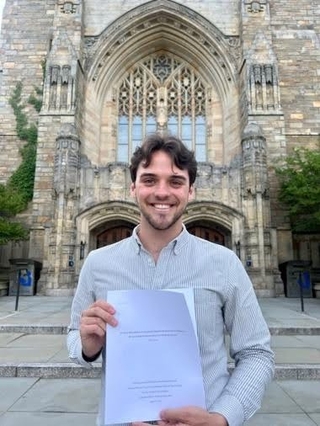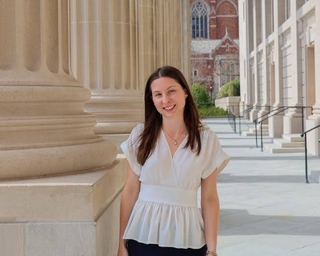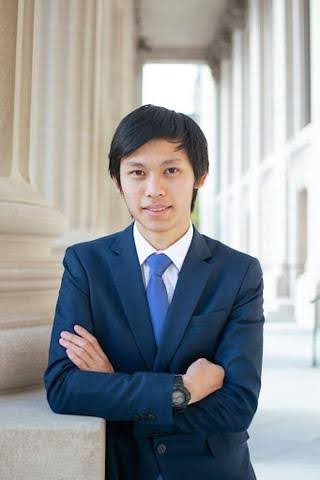Since 1999, Environmental Studies Program faculty have recognized the most outstanding senior essays for their distinguished piece of interdisciplinary scholarship. Below are the 2025 recipients of this prestigious prize. The prize is funded by an endowment from the Gaylord and Dorothy Donnelley Foundation and the Donnelley Family, in memory of Mr. Gaylord Donnelley, a conservationist dedicated to advances in research and education.
Congratulations to the 2025 Environmental Studies Senior Essay Prize Winners

Parker Chang ‘25
Parker Chang, BS Environmental Studies & Molecular, Cellular, and Developmental
Biology
Parker’s essay, “Characterizing PFAS Exposures from Residential Floor Dust Using an Integrated GC- and LC-HRMS Non-Targeted Analysis Approach,” explores indoor environmental pollutant exposure. Parker analyzed the prevalence of the environmental pollutants per-and polyfluoroalkyl substances (PFAS) in indoor residential housing spaces. By using non-targeted analytical techniques, he found that most PFAS were detected in less than ten percent of the homes analyzed. His findings are important in underscoring that PFAS exposures from floor dust can be high, and their form and severity strongly depend on housing characteristics. Understanding the connections between PFAS exposure and housing features will be important for predicting and limiting indoor air pollution.

Quinn Evans ‘25
Quinn Evans, BS Environmental Studies
Quinn’s essay, “Phenotypic Differentiation, Environmental Adaptation, and the Genetic Architecture of Divergence Between Mimulus glaucescens and Mimulus guttatus,” synthesizes his research on genetic structure and species identity in plants. For his study, he used sympatric Californian monkeyflowers with differences in ecology and adaptive phenotypes to research their genetic divergence. He conducted a large common garden experiment with the parental species and hybrids and measured reproductive, anatomical, and morphological traits, uncovering differences between the two flowers. Quinn’s findings suggest that ecological divergence required many steps to achieve and involved the diversification of genetic architectures. He shows that species identity can be kept in secondary contact despite vastly different genetic structure.

Victoria Lu ‘25
Victoria Lu, BA Environmental Studies & Art
Victoria’s essay, “Blending Citizen Stewardship into Tokyo’s Urban Green Space Governance: Implications for Megacity Planning and Policy,” is a case study of how green space are managed in Tokyo. Using findings from her summer in Tokyo in 2024, Victoria explores the city’s transition from top-down urban greenspace governance to hybrid governance models that bring in a myriad of partnerships in the public and private sector, as well as citizen stewardship. Her analysis revealed that Tokyo has successfully mixed government and participation from NGOs and private partners, but stronger citizen involvement in stewardship will be essential for creating inclusive and sustainable parks. Her case study highlights important key lessons for cities to take away in order to build a more resilient and community-centered system of green space governance. Explore her essay’s ArcGIS StoryMap

Lily O’Sullivan ‘25
Lily O’Sullivan, BS Environmental Studies
Lily’s essay, “Testing the role of convection on the long-term pattern of precipitation isotopes on a tropical island (Dominica), with applications to measuring paleotopography,” explores the use of fractionation for comparing the contributions of orographic and convective precipitation. She conducted this test to uncover whether convective precipitation influences the relationship shown between topography and isotopic fractionation. Lily found that a stratiform flow model can be used to predict isotopic fractionation in mean-state precipitation, even in a place with heavy convection. Her findings are important for the field of paleogeography and using fractionation to study precipitation processes and patterns.

Emma Polinksy ‘25
Emma Polinsky, BA Environmental Studies
Emma’s essay, “Stopping Disconnections: The Catalan Anti-Energy Poverty Movement as a Model for Autonomous Regions,” explores the issue of energy poverty and how residents can unite to create policy change that improves energy access in autonomous regions. Energy poverty, a lack of access to energy services that are safe, consistent, and affordable, is growing globally, and in Spain, some residents are cut off from electricity if they cannot afford to pay. In her essay, Emma explores how the Alliance Against Energy Poverty (APE) led to Catalan Law 24/2015, which aims to reduce energy poverty in the Catalan region of Spain through a few mechanisms. Emma analyzes how APE’s work can serve as a model for nodal governance frameworks around the world in subnational, autonomous regions struggling with energy poverty.

Sena Sugiono ‘25
Sena Sugiono, BS Environmental Studies & BA Economics
Sena’s essay, “Indonesia’s Second Independence: An Analysis of Replacing Indonesia’s Domestic Market Obligation to Eliminate its Dependence on Fossil Fuels,” compares two market mechanisms that aim to reduce the country’s fossil fuel dependence. In it, he quantifies what the impact would be of replacing Indonesia’s current Domestic Market Obligation with a Renewal Subsidy Program. Sena proposes a new subsidy program that would create a $40 billion benefit, 30% of Indonesia’s gap in funding required to meet its 2030 goals. The plan would reduce emissions, increase renewable energy generation, and create over half a million jobs. Sena’s analysis provides a promising review of a market mechanism that accelerates the energy transition and creates positive economic, social, and environmental outcomes.